You are using an out of date browser. It may not display this or other websites correctly.
You should upgrade or use an alternative browser.
You should upgrade or use an alternative browser.
Rambling thoughts on gyuto profiles
- Thread starter Kippington
- Start date

Help Support Kitchen Knife Forums:
This site may earn a commission from merchant affiliate
links, including eBay, Amazon, and others.
i support this idea 100%, and workpony grind! hehe...then stick a handle on it and call it the Panda Express!
merlijny2k
Senior Member
- Joined
- Mar 3, 2016
- Messages
- 590
- Reaction score
- 43


Personally I prefer a trapezoid as the basic shape when pondering profiles. I agree with most your steps but do a few of them differently:
First: flat spot to spine angle. Very important as it determines where on the nakiri/santoku-honesuki/garasuki spectrum you enter. Then also select heel height and length.
Next I offset the heel to neck line with the desired blade length. This gives me a line along which to put the tip.
Then select tip height and try to make those curves look good. The last one I find surprisingly dificult. It quickly starts looking like a medieval peasant knife, which is probably why they looked like that back then, it's easy to end up there. Getting a distinctly Japanese, German or French profile without copying one I find quite challenging. Many smiths with a distinctive profile claim it took them a long time to develop. The devil is, as always, in the details.
Benefits of my own line of thought over Kip's I find is that I keep more of the starting geometry towards the end, and the term tip height gets a clear meaning. Advantage of Kip's system I find is that it is more ambitious and aims to work through the process in a progression of large and important decisions towards the minor ones while in my thinking I stay more with the math/geometry subject and don't link to desired effects for the user much.
merlijny2k
Senior Member
- Joined
- Mar 3, 2016
- Messages
- 590
- Reaction score
- 43
Since many blades don't have a real flat spot but rather a curve with a radius that is lager near the heel than near the tip, I also propose to define belly as the max measurement from the heel-tip line. Devide by length to get dimensionless number if you will. Position of the top of the bellycurve can then serve as indicator for flatspot length. Can also be made into a dimensionless number.


Kippington
A small green parrot
Can you explain this line at the heel in more detail? I'm not following what you're referencing off to find it.Next I offset the heel to neck line with the desired blade length. This gives me a line along which to put the tip.
merlijny2k
Senior Member
- Joined
- Mar 3, 2016
- Messages
- 590
- Reaction score
- 43
I take a line perpendicular to the spine to the point at the corner of the heel. That is the striped line to the left. Then offset with blade length L to find the striped line to the right. Now I have a trapezoid consisting at the top of the spine, extending into the handle and extending the spine-line to the striped line to the right. At the bottom I have the line tangent to the heel, along the flat spot if the knife has one.
Basically on the left side I use the same two points you do for your triangle as vertices for the trapezoid.
Basically on the left side I use the same two points you do for your triangle as vertices for the trapezoid.
Kippington
A small green parrot
Interesting... HRC mentioned measuring tip height off the spine, similar to you.
As ecchef and Dalman brought up, a sori can really throw a spanner in the works and I feel it strongly affects your method.

Would you consider this example to have a mid-height tip? Or instead would you draw a straight line from the two highest points on the spine and treat the re-curve like a gap, in which case the handle angle would be off-set from the spine.

I like your take on the flat-spot and belly measurement - I'm going to have to think about that one for a bit... maybe open a new can of worms!
As ecchef and Dalman brought up, a sori can really throw a spanner in the works and I feel it strongly affects your method.

Would you consider this example to have a mid-height tip? Or instead would you draw a straight line from the two highest points on the spine and treat the re-curve like a gap, in which case the handle angle would be off-set from the spine.

I like your take on the flat-spot and belly measurement - I'm going to have to think about that one for a bit... maybe open a new can of worms!
Last edited:
quantumcloud509
Senior Member
Don’t see anyone talking about the inverted belly curves one can find for sale on the BST thread 
Let’s throw another variable into this. The (for lack of a better term) progressive rate of distal taper and where along the spine it begins to break. Granted, this shouldn’t affect the profile, but it will the balance point which may be especially noticeable in longer, thinner blades. Maybe this is why I prefer a bit of recurve since I typically like 240+ blade lengths. Adds a touch of tip ‘presence’ in laserish blades.
merlijny2k
Senior Member
- Joined
- Mar 3, 2016
- Messages
- 590
- Reaction score
- 43
Would you consider this example to have a mid-height tip?
Yes!
I never gave sori's much thought and certainly don't claim to have a system that elegantly accounts for them.
I don't have any knives that feature them. The locally popular knife from local celebrity chef Herman Den Blijker used to have one. He has a new model out and i'm not sure about that one.
Doing as you described makes most sense to me.
HRC_64
Senior Member
- Joined
- Aug 8, 2017
- Messages
- 2,714
- Reaction score
- 595
One idea for the belly discussion --
Put a line from the heel to the tip.
Then take this line and copy it (cmd-c),
Move it over so its now tangent w/profile
Now marke orthogonal to the tangent line,
into the "front" of the curve, and the "back" behind the curve,
as our tangent point can "estimate" apex of belly
Since the tangent point can be further back
or further forward to the tip,
its useful to know where it is
(ie, proportionatey along a relative continuum).
(This method may not be perfect but it
is I believe repeatable and comparable over many
different blade shapes.)
Put a line from the heel to the tip.
Then take this line and copy it (cmd-c),
Move it over so its now tangent w/profile
Now marke orthogonal to the tangent line,
into the "front" of the curve, and the "back" behind the curve,
as our tangent point can "estimate" apex of belly
Since the tangent point can be further back
or further forward to the tip,
its useful to know where it is
(ie, proportionatey along a relative continuum).
(This method may not be perfect but it
is I believe repeatable and comparable over many
different blade shapes.)
Larrin
Senior Member
- Joined
- Mar 13, 2011
- Messages
- 723
- Reaction score
- 1,033
You lost me at orthogonal to the tangent line in front of the curve and the back behind the curve.One idea for the belly discussion --
Put a line from the heel to the tip.
Then take this line and copy it (cmd-c),
Move it over so its now tangent w/profile
Now marke orthogonal to the tangent line,
into the "front" of the curve, and the "back" behind the curve,
as our tangent point can "estimate" apex of belly
Since the tangent point can be further back
or further forward to the tip,
its useful to know where it is
(ie, proportionatey along a relative continuum).
(This method may not be perfect but it
is I believe repeatable and comparable over many
different blade shapes.)
When I'm by the grinder, I typically roll the edge on a flat surface, that will typically tell me if I need adjustments my eye did'nt catch, works like a charm every time, repeatable and for every different size/model 
The way HRC was talking i would love to see some knife profiles that shapes of mathematical equations.
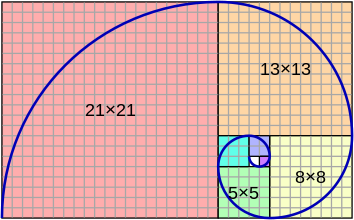
Fibonacci spiral. ... if you were to Un-coil it and see what happens with the edge.

Basically use the "GOLDEN RATIO" and apply it to a knife for the profile, spind and edge?
Its seen an insane amount in nature as the perfect ratio ...


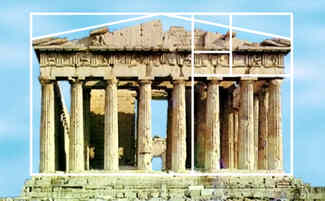
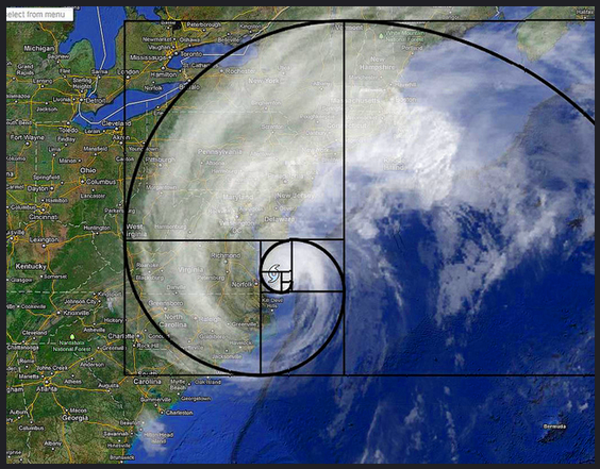
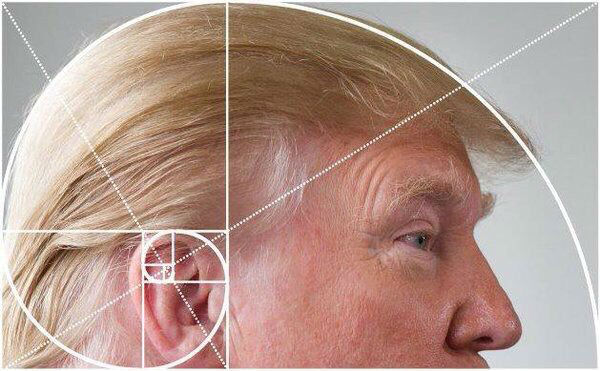
Ok, that last one is a joke

Fibonacci spiral. ... if you were to Un-coil it and see what happens with the edge.

Basically use the "GOLDEN RATIO" and apply it to a knife for the profile, spind and edge?
Its seen an insane amount in nature as the perfect ratio ...





Ok, that last one is a joke
HRC_64
Senior Member
- Joined
- Aug 8, 2017
- Messages
- 2,714
- Reaction score
- 595
You lost me at orthogonal to the tangent line in front of the curve and the back behind the curve.
orthogonal means "line at 90*"
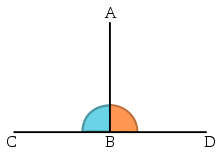
"into the "front" of the curve, and the "back" behind the curve"
ie orange is "front".... assuming d=front/tip, and c=heel)
should be self explanatory w/ picture.
[edit: see below]
[or more precisey...]
Attachments
Last edited:
merlijny2k
Senior Member
- Joined
- Mar 3, 2016
- Messages
- 590
- Reaction score
- 43
You lost me at orthogonal to the tangent line in front of the curve and the back behind the curve.
Me too at the exact same line
merlijny2k
Senior Member
- Joined
- Mar 3, 2016
- Messages
- 590
- Reaction score
- 43
While we are rambling. Some thoughts on fun things that can ultimately be done with a mathematical model that translates knife shapes into a finite set of indicator numbers:
Computer analysis of profile pictures. Computer could then find similar profiles in a database.
Computer aided profile design. You could play with the indicators and watch the knife shape evolve. Coupled with a laser cutter and CNC mill you could even design a shape and have the blank for it ready in about an hour. Of course you woyld still have to harden, finish, handle and dharpen but still.
You design your own profile and have the computer select closest profile shape from database.
I don't have all the skills necessary to pull it off but last year I coached a tech savvy student with his thesis. He built a parametric design model for an offshore jacket structure in Excell that then translated to a 3d graphic model. Of course he had some assistance from the company and he pulled a few smart tricks I probably would not have been able to come up with myself but it was nonetheless relatively straightforward. And having a good parametric model to start from really is key to success.
I have seen other members say we should have a profiles database just like z's steel database. I really believe it can be done too. Having a vector image based on indicators is then highly desirable over just storing raster images.
Computer analysis of profile pictures. Computer could then find similar profiles in a database.
Computer aided profile design. You could play with the indicators and watch the knife shape evolve. Coupled with a laser cutter and CNC mill you could even design a shape and have the blank for it ready in about an hour. Of course you woyld still have to harden, finish, handle and dharpen but still.
You design your own profile and have the computer select closest profile shape from database.
I don't have all the skills necessary to pull it off but last year I coached a tech savvy student with his thesis. He built a parametric design model for an offshore jacket structure in Excell that then translated to a 3d graphic model. Of course he had some assistance from the company and he pulled a few smart tricks I probably would not have been able to come up with myself but it was nonetheless relatively straightforward. And having a good parametric model to start from really is key to success.
I have seen other members say we should have a profiles database just like z's steel database. I really believe it can be done too. Having a vector image based on indicators is then highly desirable over just storing raster images.
Kippington
A small green parrot
Oh wow, not only do you use the same tip height measurement technique as merlijn, but you use the same belly measuring method too, albeit a different way of wording it!
Does anyone else use this method? I hadn't thought of it like this.
---------------------------
Lucas, as beautiful as the Fibonacci spiral is, I really don't think it works in any way on the belly curve.
It's quite difficult to come up with an elegant and simple way of describing the dynamics of the curve. It's one of those more intuitive things, like throwing and catching a ball vs doing the math to work it out.
It won't stop us from trying though!
Last edited:
Mute-on
Senior Member
By way of example, I have always found the Shigefusa gyuto profile instrinsically appealing. The angles, curves and proportions appear visually balanced to me.
Marko Tsourkan and Will Catcheside also produce similarly well resolved gyuto profiles. The Fibonacci proportions of the knife world, so to speak ...
Oh, and that Kippington bloke makes a pretty nice looking blade too ...
Marko Tsourkan and Will Catcheside also produce similarly well resolved gyuto profiles. The Fibonacci proportions of the knife world, so to speak ...
Oh, and that Kippington bloke makes a pretty nice looking blade too ...
I'm just thinking here...
might apply to handle length vs blade length. Vs height of blade? vs machi length? vs spine thickness? vs choil thickness? -- I don't know but is that why 240mm gyutos are so popular?
Length of the blade that you pinch vs the length of blade exposed
Average length of product cut vs length of blade available.
Length of flat spot vs length of curve/up sweep of the blade. ***kippington**
Circumference of handle vs length of hand.
Height of blade at heel vs mid & tip
Surface area of back third vs mid third vs last tip third.
Ratio between ura and omote (single bevel)-- actually this one is probably true.
- there is a whole wackload of possibilities
might apply to handle length vs blade length. Vs height of blade? vs machi length? vs spine thickness? vs choil thickness? -- I don't know but is that why 240mm gyutos are so popular?
Length of the blade that you pinch vs the length of blade exposed
Average length of product cut vs length of blade available.
Length of flat spot vs length of curve/up sweep of the blade. ***kippington**
Circumference of handle vs length of hand.
Height of blade at heel vs mid & tip
Surface area of back third vs mid third vs last tip third.
Ratio between ura and omote (single bevel)-- actually this one is probably true.
- there is a whole wackload of possibilities
i was not a fan of shig profile, and i had to alter the edge shape on my marko when i first got it cause it was too flat, kept digging into the board..By way of example, I have always found the Shigefusa gyuto profile instrinsically appealing. The angles, curves and proportions appear visually balanced to me.
Marko Tsourkan and Will Catcheside also produce similarly well resolved gyuto profiles. The Fibonacci proportions of the knife world, so to speak ...
Oh, and that Kippington bloke makes a pretty nice looking blade too ...
You started a very interesting discussion Kippington! You (and others!) have made very interesting points. It also comes down to the fact, whether the person is looking at this as a knife user (who is trying to describe his/her preferences) or a knifemaker, who is trying to come up with a set of 'parameters' that will help him/her to somehow translate the wanted properties of a finished knife to geometrical parameters.
From my point of view (amateur knifemaker) most relevant parameters have been mentioned (inclusive very interesting & important user feedback) - like 'height of the tip', 'angle of the handle', 'shape (height) of the emoto v.r.t. knife height', 'shape of the tip' and also - the VERY important one - the relative height of the counter-top to the person. The last one has big impact on what knife shape will feel comfortable. For example - I am not particularly tall, but our counter-top is and so I tend to prefer knives that have a bit flatter profile and angle of the handle rather small. Otherwise the end of the handle will have tendency to hit my forearm (or it will require to hold the knife such that the handle will pass by my forearm).
One parameter that is directly influenced by the parameters already discussed and has big impact on how a knife feel in hand is weight and its distribution. If the blade profile is like on Masashi (or Wat or Toyama) - there will be a lot of steel close to the tip. Not only this shifts the center of mass away from the heel, but it also changes how the knife feels when moved (rotated - as cutting is partially a rotary movement) - that relatively large mass close the tip will make the knife feel less nimble, but cutting with more ease because of this weight. Of course - distal taper also can and does influence this. Knives like some of the Hide gyutos I have seen with not too pronounced distal taper will also have the center of mass further away from the heel.
Parameter that can be used to adjust the center of mass (at expense of additional weight) are handle length and materials. I find that for a Sakai-like knife (thing Konosuke, Ichimonji and similar) knife that is not too tall (usually around 48-49 mm) and relatively low weither of 180 - 200g a traditional HO wood WA handle works well and these knives feel very nimble. But with a knife like 240 Watanabe a bit heavier and longer handle helps to bring the centre of mass back a little and makes the knife fell more balanced. But that reflects my personal preference and not a universal truth.
The 'spine recurve' mentioned by Robin (this is something that tends to happen in quench) can allow the combination of large angle of handle AND taller blade closer to the tip.
From my point of view (amateur knifemaker) most relevant parameters have been mentioned (inclusive very interesting & important user feedback) - like 'height of the tip', 'angle of the handle', 'shape (height) of the emoto v.r.t. knife height', 'shape of the tip' and also - the VERY important one - the relative height of the counter-top to the person. The last one has big impact on what knife shape will feel comfortable. For example - I am not particularly tall, but our counter-top is and so I tend to prefer knives that have a bit flatter profile and angle of the handle rather small. Otherwise the end of the handle will have tendency to hit my forearm (or it will require to hold the knife such that the handle will pass by my forearm).
One parameter that is directly influenced by the parameters already discussed and has big impact on how a knife feel in hand is weight and its distribution. If the blade profile is like on Masashi (or Wat or Toyama) - there will be a lot of steel close to the tip. Not only this shifts the center of mass away from the heel, but it also changes how the knife feels when moved (rotated - as cutting is partially a rotary movement) - that relatively large mass close the tip will make the knife feel less nimble, but cutting with more ease because of this weight. Of course - distal taper also can and does influence this. Knives like some of the Hide gyutos I have seen with not too pronounced distal taper will also have the center of mass further away from the heel.
Parameter that can be used to adjust the center of mass (at expense of additional weight) are handle length and materials. I find that for a Sakai-like knife (thing Konosuke, Ichimonji and similar) knife that is not too tall (usually around 48-49 mm) and relatively low weither of 180 - 200g a traditional HO wood WA handle works well and these knives feel very nimble. But with a knife like 240 Watanabe a bit heavier and longer handle helps to bring the centre of mass back a little and makes the knife fell more balanced. But that reflects my personal preference and not a universal truth.
The 'spine recurve' mentioned by Robin (this is something that tends to happen in quench) can allow the combination of large angle of handle AND taller blade closer to the tip.
merlijny2k
Senior Member
- Joined
- Mar 3, 2016
- Messages
- 590
- Reaction score
- 43
So far we have four parameters for the blade curve: heel point, velly point and tip, and the angle at the heel. Gives you a fourth order polynomial equation. I'd say fourth order should be sufficient for a single curve if you have the correct parameters. I think these four should do fine but have been wrong and surprised too many times before. Not too recently been proven wrong by some guy known as kip....
Kippington
A small green parrot
This is my way of seeing it - not necessarily any better or worse than the ways above.
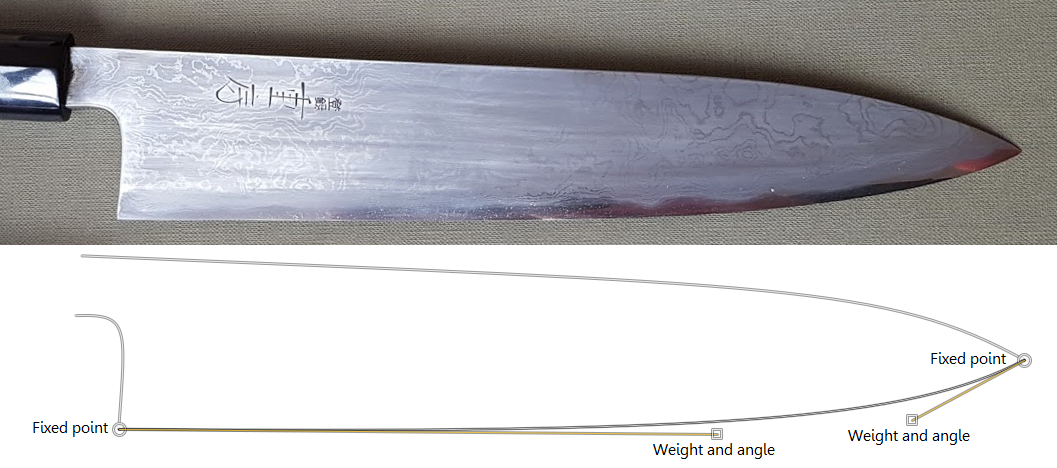 The fixed points represent the heel and the tip... simple enough. The yellow lines represent the starting angle of the curve between the points, and the length of each yellow line indicates the amount of weight, or influence, each angle has on the curve.
The fixed points represent the heel and the tip... simple enough. The yellow lines represent the starting angle of the curve between the points, and the length of each yellow line indicates the amount of weight, or influence, each angle has on the curve.
Even though both yellow lines say 'Weight and angle', in my mind the angle coming out of the heel is always a flat zero as if the flat spot were resting on the board. This gives me a reference with which I use to measure the angle of the tip. It also means that the spine or handle would always have a slight angle to be measured as well (I don't like using the spine as the reference point).
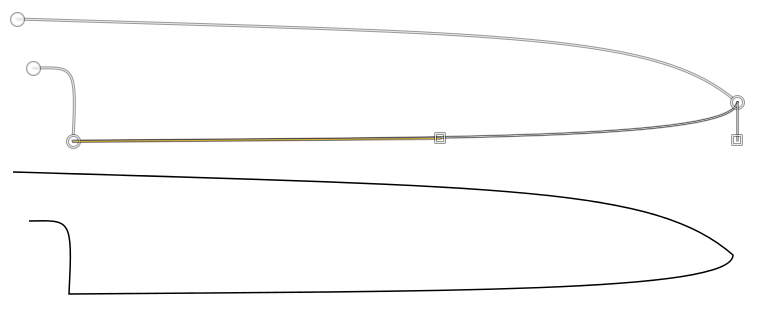 (but maybe it's not too surprising to some people)
(but maybe it's not too surprising to some people)
With looks only a mother could love, we won't be seeing this one in the stores any time soon.
Actually I'm just reminded - A kitchen I used to work at has called me to fix up all their knives that were "professionally sharpened" by a dude with a belt grinder. He came on a closed day and rounded the tips (like the picture above) and the heels on every. single. knife...
I'll take a picture in the next couple of days, its shockingly bad.

Even though both yellow lines say 'Weight and angle', in my mind the angle coming out of the heel is always a flat zero as if the flat spot were resting on the board. This gives me a reference with which I use to measure the angle of the tip. It also means that the spine or handle would always have a slight angle to be measured as well (I don't like using the spine as the reference point).
I'm guessing we all know that the angle of the tip is what causes this board-digging, but surprisingly the height of the tip has very little to do with it. For example, here would be a gyuto with hardly any belly (very flat) which could still be rocked high without digging the tip into the board:i had to alter the edge shape on my marko when i first got it cause it was too flat, kept digging into the board..

With looks only a mother could love, we won't be seeing this one in the stores any time soon.
Actually I'm just reminded - A kitchen I used to work at has called me to fix up all their knives that were "professionally sharpened" by a dude with a belt grinder. He came on a closed day and rounded the tips (like the picture above) and the heels on every. single. knife...
I'll take a picture in the next couple of days, its shockingly bad.
Last edited:
Digging into the board was probably meant when the flat spot is ‘too flat’ and the either the heel itself or the geometrically straight flat spot catches on the unevenness of the cutting board. The important point is - flat spot should never be completely flat and there should be a tiny upcurve towards the heel.
Kippington
A small green parrot
Ah I see.
I agree with what you say about the tiny up-curve (many knives have it) but I don't think it's always necessary. If the transition from belly into flat spot is executed well (a very gradual transition), the knife can still move smoothly on a board without a small up-sweep at the heel. It's difficult to get right, though.
For example, I don't think the Shig photo in my post above has an up-sweep at the heel. I might be wrong though.
I agree with what you say about the tiny up-curve (many knives have it) but I don't think it's always necessary. If the transition from belly into flat spot is executed well (a very gradual transition), the knife can still move smoothly on a board without a small up-sweep at the heel. It's difficult to get right, though.
For example, I don't think the Shig photo in my post above has an up-sweep at the heel. I might be wrong though.
Last edited:
The upcurve towards the heel is usually very subtle, I would see it more as a continuation of the very gentle curve most flat spots have. But as you say - different knives are ground differently.
And to come back to the angle at the tip you mentioned above - that is an important, but also a rather complex topic as the curve towards the tip may have very different shape.





